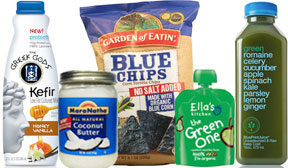 hile furthering its footprint in the United Kingdom remains a top goal for The Hain Celestial Group, the Lake Success, N.Y.-based company believes the United States is just as ripe for opportunity.
hile furthering its footprint in the United Kingdom remains a top goal for The Hain Celestial Group, the Lake Success, N.Y.-based company believes the United States is just as ripe for opportunity.In a May 14 presentation at the BMO Farm to Market Conference in New York, John Carroll, executive vice-president of Hain and chief executive officer of Hain Celestial United States, said he is asked often whether Hain is bullish about the United States.
“The answer is yes,” he said. “I mean, we really believe the bull will snort, and it always does. We really believe there is a lot more opportunity for us in the U.S.”
He identified several key reasons for his optimism, beginning with the fact that few categories are growing as fast as natural and organic.
“We’re in an on-trend category,” he said.
Innovation and sales force organization continue to drive consumption, Mr. Carroll said.
“We always need to be pushing innovation,” he said, pointing to products such as Greek Gods kefir, MaraNatha coconut butter and Garden of Eatin’ chia tortillas as examples. Mr. Carroll mentioned that chia “is a commodity on fire,” and Hain is in the process of developing a domestic source of chia, a move he believes will make Hain one of the first companies to do so, and a move that ultimately will increase the company’s chia supply.
In terms of sales force, Mr. Carroll said Hain is able to do what a lot of other natural organic companies cannot — find the top customers and build teams around them.
“If you want to play beyond natural, that’s what the major supermarkets, mass merchandisers and others are looking for,” Mr. Carroll said. He noted Hain has a team in Bentonville, Ark. (for Wal-Mart), a team in Minneapolis (for Target), a team in Cincinnati (for Kroger) and a team in Florida (for Publix).
“We are focused and dedicated to driving business in these accounts, and we’re seeing the results of it,” he said.
Acquisitions also are a key component to success in the United States, including two — BluePrint and Ella’s Kitchen — that have taken effect in the past six months, Mr. Carroll said.
“BluePrint juice is a fresh, pressed raw and organic juice used both for cleansing and regular juice consumption,” Mr. Carroll said. “These products are spectacular, and what we like about this business is two-fold. One, we see great top-line distribution opportunities. One of our key strategies is to find businesses with a lot of distribution runway, put them through our sales force, which I talked to you about previously, and drive growth. We’ve seen since we have added this business that we’ve added five to six new Whole Foods regions, we’re about to do a test in a major Northeast retailer and we really think this business is poised to grow significantly not only in natural but also in key strategic grocery partners.”
Meanwhile, the acquisition of Ella’s Kitchen, a maker of organic baby food with 80 products offered in the United Kingdom, the United States and Scandinavia, is seen as a high-growth complement to Hain’s Earth’s Best business, he said.
“We like the Ella’s business so much, we’re actually going to create a global infant feeding unit with Ella’s and Earth’s Best,” Mr. Carroll said. “The important thing about Ella’s and Earth’s Best is as you go through the product lines and you look at the customers in terms of consumers, there’s not a lot of overlap because Ella’s was the first premium baby food in a pouch. Earth’s Best is the leading organic baby food in both the pouch and the jar.”
Mr. Carroll said there is “an opportunity to drive enormous synergies” both on a revenue basis as well as on the margin side.
A final reason Hain continues to be bullish on the U.S. market is productivity savings. Over the last four or five years, Mr. Carroll said Hain has driven a compound annual growth rate of more than 27% in productivity savings, to over $20 million this year.
He said the company’s move to bring Earth’s Best pouch production in-house has generated significant savings and has allowed Hain to be more competitive.
The company also has found ways to drive savings through plant utilization and logistics. Mr. Carroll cited the company’s decision to go to a 24/7 production plan at its MaraNatha nut butters plant in Ashland, Ore., as an example.
“Basically every ounce of overhead is utilized and double utilized to drive this business to the point where we’re saying, ‘okay, guess what, we can actually now go and look for more capacity because we’ve used everything we can here,’” he said.





